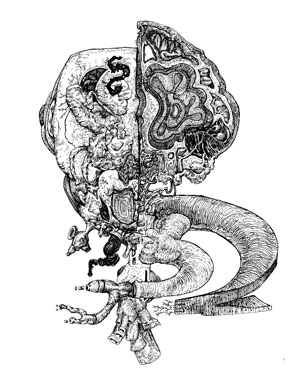About
About Suspicious Anatomy

From the genre-chainsawing minds Ethan Gould and Wythe Marschall of the Hollow Earth Society comes the definitive guide to the horrifying world inside you—finally available in lush, illustrated paperback!
In the tradition of John Hodgman, David Cronenberg, and H. P. Lovecraft, The Human Cranius explores an alternative anatomy at once mesmerizing and deeply unsettling. Gould and Marschall ask: What do we know about our own bodies? The answer: Very little...
The modern human sciences may have given us the keys to our unconscious minds, but they've left entirely to the cold, uncaring laboratory the most vital workings of our bodies.
What does it feel like to have guts? To face disease, age, mutation—a self that is not only not whole but not even on its own side?
The Suspicious Anatomy series seeks to address these physio–psychomological quandaries by producing, for your benefit, the entire unconscious of the body, the shadow-self, in words and elaborate images.
☛ BUY THE BOOK! ☚
About the Hollow Earth Society

For over one hundred years, the Hollow Earth Society has probed the world's most bizarre and pertinent mysteries via an ever-mutating set of handbooks, rogue histories, and practical manuals. The Society is currently led by Colonels Ethan Gould and Wythe Marschall.
Ethan Gould is a Brooklyn-based artist working in drawing, puppetry, writing, and video to exploit the moments when the formerly robust process of perceptual categorization snaps like the fragilest of dry twigs. A graduate of the University of Rochester, he helped to create several development programs at the American Folk Art Museum. His work has appeared in such disparate places as the Ontological-Hysteric Theater, The Assembly Theater Company, The Brooklyn Review, Pomp & Circumstance, and ABC's Wife Swap.
Wythe Marschall is a writer. A graduate of Bennington College and the MFA fiction program at Brooklyn College, where he teaches undergraduate literature, Wythe has published stories and essays in McSweeney's Quarterly Concern, Ninth Letter, and elsewhere. He is the senior editor of the Atlas Obscura and an editor of Pomp & Circumstance, as well as a frequent reader for Electric Literature. His thoughts on letters, postmodernity, and hip hop can be found on his website, chronolect.com.
Contact
- Ethan: ethan [at symbol] hollowearthsociety.com
- Wythe: wythe [at symbol] hollowearthsociety.com
The Physical-Surreal Manifestage
Suspicious Anatomy does not purport to represent or speak on behalf of anything; it seeks rupture with discourses. Or should we say, with the discourses that it, in some ways, reminds us of. Because Suspicious Anatomy is not a discourse, and cannot prove anything. It is pure Surrealism—the mutilation, combination, and recombination of discourses (or, at the molecular level, of images and words associated with those discourses) towards the Impossible Discourse: The (Unconscious) Mind. Or, in our case...? The Unconscious Body?
Why the "Unconscious" Body? Because: Readers know nothing of the truths of their own bodies, nor could they; a "true knowledge" of anatomy is beyond most humans even at its surface (microbiology, histology, phylogenetics, etc.); a deeper truth—an empathy with the spark of Creation—lies beyond the bounds of science entirely. Only prophets and madmen claim to possess this deeper knowledge, the carnal gnosis, and we are, if mad, not prophetic (or is it vice versa?), and perhaps neither.
In any case, we seek rupture—diagonal knowledge, a new type of knowledge which is neither transcendent and representational (book, knowledge, science, art, the tree growing up in imitation of the Real's roots)...
nor immanent and asignifying (the haiku, the nightmare, hypernarrative machines of Kafka that reproduce themselves along several, potentially random lines of inquiry with equal thematic power)...,but a knowledge that is at once Surreal (more than possible—a quality shared by the immanent)...as well as physically signifying—and therefore anatomically transcendent (a reflection of the Real—a quality shared with the trees).